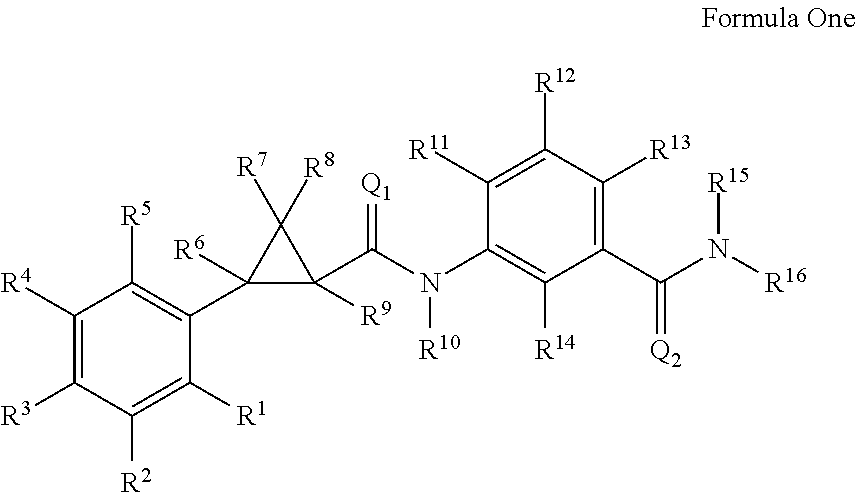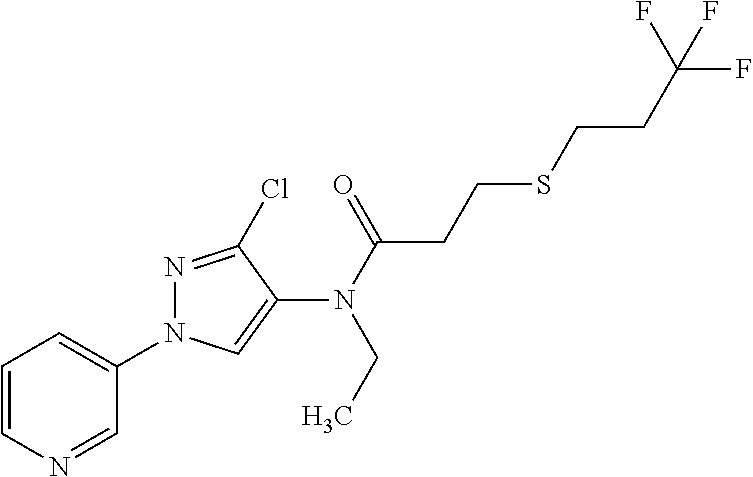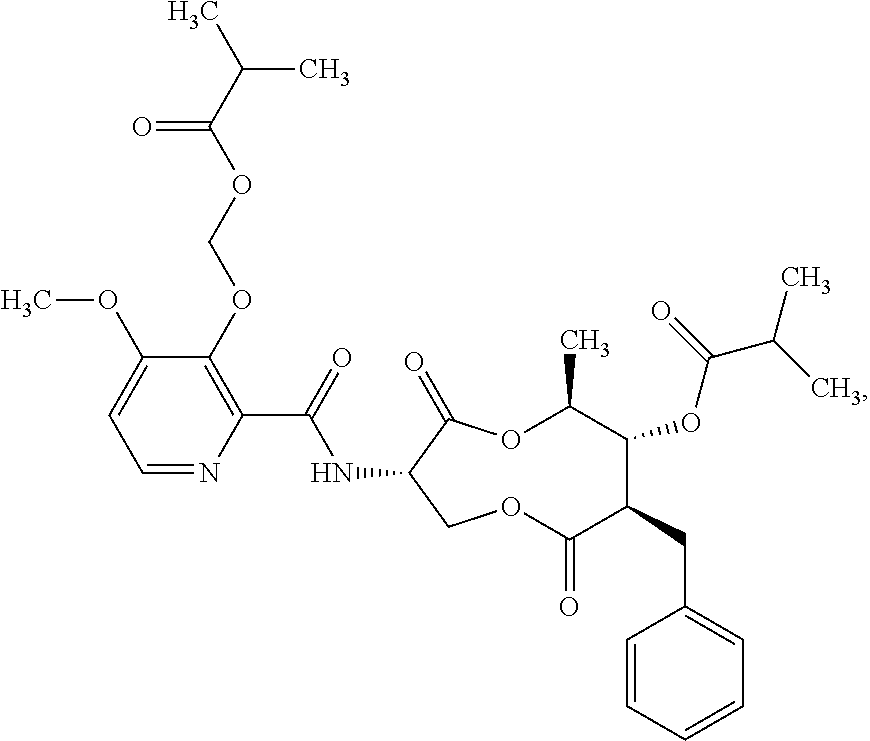Molecules having pesticidal utility, and intermediates, compositions, and processes, related thereto
a technology of pesticidal utility and molecules, applied in the field of molecules having pesticidal utility, can solve the problems of destroying more than 40% of all food production, prone to loss, and often one of the most insidious and costly problems
- Summary
- Abstract
- Description
- Claims
- Application Information
AI Technical Summary
Benefits of technology
Problems solved by technology
Method used
Image
Examples
example 1
on of trans-2,2-dichloro-3-(3,5-dichlorophenyl)cyclopropanecarboxylic acid (C1)
[0229]
[0230]Ruthenium(III) chloride (0.080 g, 0.39 mmol) was added to a stirred mixture of trans-1,3-dichloro-5-(-2,2-dichloro-3-(4-methoxyphenyl)cyclopropyl)benzene (C22) (2.8 g, 7.7 mmol) and sodium periodate (33 g, 160 mmol) in water:ethyl acetate:acetonitrile (8:1:1, 155 mL) at 23° C. The resulting biphasic brown mixture was vigorously stirred at 23° C. for 5 hours. The reaction mixture was diluted with water (1000 mL) and extracted with dichloromethane (4×200 mL). The combined organic layers were dried over magnesium sulfate, filtered, and concentrated. The residue was diluted with a sodium hydroxide solution (1 M, 100 mL) and washed with diethyl ether (4×50 mL). The aqueous layer was adjusted to pH 2, using concentrated hydrochloric acid, and extracted with dichloromethane (3×50 mL). The combined organic layers were dried over magnesium sulfate, filtered, and concentrated to afford the title product...
example 2
on of trans-2,2-dichloro-3-(4-(trifluoromethyl)phenyl)cyclopropanecarboxylic acid (C4)
[0236]
[0237]To a stirred mixture of trans-1-(2,2-dichloro-3-(4-(trifluoromethyl)phenyl)cyclopropyl)-4-methoxybenzene (C25) (3.50 g, 9.60 mmol) and sodium periodate (30.8 g, 144 mmol) in water:ethyl acetate:acetonitrile (8:1:1, 200 mL) was added ruthenium(III) chloride (0.100 g, 0.400 mmol) at 23° C. The resulting mixture was vigorously stirred at 23° C. for about 5 hours. The reaction mixture was diluted with dichloromethane and washed with water. The combined organic layers were dried over sodium sulfate, filtered, and concentrated. Purification by flash column chromatography provided the title compound as an off-white solid (0.630 g, 38%): mp 100-102° C.; 1H NMR (400 MHz, DMSO-d6) δ 13.43 (brs, 1H), 7.77-7.73 (m, 2H), 7.67-7.64 (m, 2H), 3.55 (d, J=8.8 Hz, 1H), 3.44 (d, J=8.8 Hz, 1H); ESIMS m / z 347 ([M−H]−).
[0238]The following compounds were prepared in like manner to the procedure outlined in Exa...
example 3
on of trans-1,3-dichloro-5-(2,2-dichloro-3-(4-methoxyphenyl)cyclopropyl)benzene (C22)
[0273]
[0274]Aqueous sodium hydroxide (50%, 6.8 mL, 130 mmol) was added to a stirred solution of (E)-1,3-dichloro-5-(4-methoxystyryl)benzene (C43) (2.4 g, 8.6 mmol) and N-benzyl-N,N-diethylethanaminium chloride (0.20 g, 0.86 mmol) in chloroform (14 mL, 170 mmol) at 23° C. The resulting biphasic, dark brown mixture was vigorously stirred at 23° C. for 24 hours. The reaction mixture was diluted with water (200 mL) and extracted with dichloromethane (2×100 mL). The combined organic layers were dried over magnesium sulfate, filtered, and concentrated to afford the title product as a brown oil (2.8 g, 90%): 1H NMR (400 MHz, CDCl3) δ 7.34 (t, J=1.8 Hz, 1H), 7.21-7.30 (m, 4H), 6.93 (m, 2H), 3.83 (s, 3H), 3.14 (d, J=8.5 Hz, 1H), 3.08 (d, J=8.5 Hz, 1H); IR (thin film) 3075 (w), 2934 (w), 2836 (w), 1724 (w), 1640 (w), 1609 (m), 1584 (m), 1568 (s), 1513 (s) cm−1.
[0275]The following compounds were prepared in li...
PUM
 Login to View More
Login to View More Abstract
Description
Claims
Application Information
 Login to View More
Login to View More - R&D
- Intellectual Property
- Life Sciences
- Materials
- Tech Scout
- Unparalleled Data Quality
- Higher Quality Content
- 60% Fewer Hallucinations
Browse by: Latest US Patents, China's latest patents, Technical Efficacy Thesaurus, Application Domain, Technology Topic, Popular Technical Reports.
© 2025 PatSnap. All rights reserved.Legal|Privacy policy|Modern Slavery Act Transparency Statement|Sitemap|About US| Contact US: help@patsnap.com



